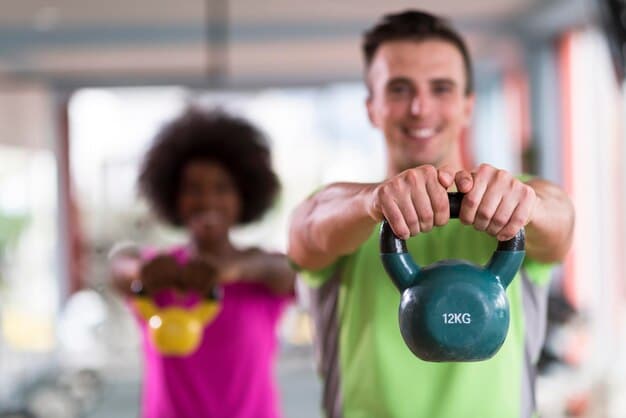Transform Your Body: Kettlebell Full-Body Workout Routine

Transform Your Body with Kettlebells: A Full-Body Workout Routine offers an efficient and effective way to build strength, burn fat, and improve overall fitness, providing a comprehensive workout using just one versatile piece of equipment.
Ready to transform your body with kettlebells: a full-body workout routine that’s both efficient and effective? Kettlebells offer a fantastic way to build strength, improve cardiovascular fitness, and increase flexibility, all in one dynamic workout. Let’s dive into how you can achieve your fitness goals with this versatile tool.
Unlocking Full-Body Fitness with Kettlebells
Kettlebells have surged in popularity as a go-to tool for achieving full-body fitness. Unlike traditional dumbbells, the kettlebell’s offset center of gravity engages more muscles, leading to a more dynamic and functional workout. This makes kettlebells an excellent choice for anyone looking to build strength, endurance, and flexibility simultaneously.
The Benefits of Kettlebell Training
Kettlebell training offers a wide range of benefits that can significantly improve your overall fitness. From enhancing cardiovascular health to increasing muscular strength, kettlebells provide a comprehensive workout solution.
- Improved Cardiovascular Health: Kettlebell exercises often involve high-intensity movements that elevate your heart rate, boosting cardiovascular health.
- Increased Muscular Strength and Endurance: The dynamic nature of kettlebell workouts engages multiple muscle groups, leading to increased strength and endurance.
- Enhanced Flexibility and Mobility: Many kettlebell exercises require a full range of motion, improving flexibility and mobility.
- Efficient Calorie Burning: Kettlebell workouts are highly effective for burning calories, making them a great choice for weight loss.
Incorporating kettlebells into your workout routine can lead to significant improvements in your physical fitness and overall well-being.

Essential Kettlebell Exercises for a Full-Body Transformation
To effectively transform your body with kettlebells, it’s crucial to incorporate a variety of exercises that target different muscle groups. Mastering these essential movements will enable you to build a well-rounded and functional physique.
Let’s explore some key kettlebell exercises that can form the foundation of your full-body workout routine.
Kettlebell Swing
The kettlebell swing is a foundational exercise that engages numerous muscle groups, including the glutes, hamstrings, core, and shoulders. It’s a powerful movement that can improve cardiovascular fitness and build explosive power.
To perform a kettlebell swing, stand with your feet shoulder-width apart, holding the kettlebell with both hands. Hinge at your hips, keeping your back straight, and swing the kettlebell back between your legs. Then, explosively drive your hips forward, swinging the kettlebell up to chest height. Control the descent and repeat.
Goblet Squat
The goblet squat is an excellent exercise for building lower body strength and improving core stability. Holding the kettlebell close to your chest enhances core engagement and promotes proper squatting mechanics.
To perform a goblet squat, hold the kettlebell close to your chest with both hands. Stand with your feet slightly wider than shoulder-width apart and toes slightly pointed out. Squat down, keeping your back straight and chest up, until your thighs are parallel to the ground. Push through your heels to return to the starting position.
Kettlebell Snatch
The kettlebell snatch is an advanced movement that requires coordination, strength, and power. It involves lifting the kettlebell from the ground to an overhead position in one fluid motion.
Stand with your feet shoulder-width apart, with the kettlebell in front of you. Hinge at your hips and grip the kettlebell. Swing the kettlebell back between your legs and then explosively pull it upward, guiding it overhead. Lock out your arm at the top and then lower the kettlebell back down, controlling the descent.
Designing Your Kettlebell Workout Routine
Crafting an effective kettlebell workout routine requires careful consideration of exercise selection, sets, reps, and rest periods. It’s essential to create a program that aligns with your fitness goals and current fitness level.
Here’s a sample kettlebell workout routine that you can adapt to your needs:
- Warm-up (5-10 minutes): Dynamic stretching and light cardio
- Kettlebell Swing: 3 sets of 15-20 reps
- Goblet Squat: 3 sets of 10-12 reps
- Kettlebell Snatch: 3 sets of 8-10 reps per arm
- Kettlebell Clean and Press: 3 sets of 8-10 reps per arm
- Kettlebell Turkish Get-Up: 1-2 reps per side
- Cool-down (5-10 minutes): Static stretching

Progressing Your Kettlebell Training
To continually transform your body with kettlebells, it’s vital to progressively increase the challenge of your workouts. This can involve increasing the weight of the kettlebell, adding more reps or sets, or incorporating more complex exercises.
Increasing Kettlebell Weight
As you become more comfortable with your current kettlebell weight, consider increasing it to further challenge your muscles. Start with small increments to avoid injury and maintain proper form.
Adding Reps and Sets
Another way to progress your kettlebell training is to add more reps or sets to your workouts. This increases the overall volume of your training, leading to greater strength and endurance gains.
Aim to gradually increase the number of reps or sets over time, rather than making drastic changes all at once.
Incorporating More Complex Exercises
As you gain more experience with kettlebell training, consider incorporating more complex and challenging exercises into your routine. This can help to improve your coordination, balance, and overall athleticism.
- Kettlebell Windmill: Improves core stability and shoulder mobility.
- Kettlebell Renegade Row: Builds upper body strength and core stability.
- Kettlebell Figure 8: Enhances coordination and core engagement.
Progressive overload is crucial for continued progress in kettlebell training. By continually challenging your body, you can achieve greater strength, endurance, and overall fitness gains.
Nutrition and Recovery for Kettlebell Training
Proper nutrition and recovery are essential components of any successful fitness program, including kettlebell training. Fueling your body with the right nutrients and allowing adequate time for rest and recovery can optimize your results and minimize the risk of injury.
Let’s discuss some key nutrition and recovery strategies for kettlebell training.
Fueling Your Workouts
To maximize your performance during kettlebell workouts, it’s important to fuel your body with the right nutrients. This includes consuming a balanced diet that is rich in protein, carbohydrates, and healthy fats.
Consider consuming a pre-workout meal or snack that provides sustained energy, such as a piece of fruit with a handful of nuts or a protein shake. Additionally, stay hydrated by drinking plenty of water before, during, and after your workouts.
Prioritizing Recovery
Recovery is just as important as the workouts themselves when it comes to achieving your fitness goals. Adequate rest allows your muscles to repair and rebuild, leading to greater strength and performance gains.
Aim to get at least 7-8 hours of sleep per night and incorporate rest days into your workout schedule. Additionally, consider incorporating recovery techniques such as foam rolling, stretching, and massage to alleviate muscle soreness and promote relaxation.
Staying Safe with Kettlebell Training
Safety should always be a top priority when engaging in any form of exercise, including kettlebell training. Proper form, technique, and warm-up protocols can help you minimize the risk of injury and maximize the benefits of your workouts.
Let’s discuss some key safety considerations for kettlebell training.
Mastering Proper Form
Proper form is essential for preventing injuries and maximizing the effectiveness of kettlebell exercises. If you’re new to kettlebell training, consider working with a qualified instructor to learn the correct form and technique.
Pay close attention to your body mechanics and avoid rounding your back or using momentum to swing the kettlebell. Engage your core muscles throughout each exercise to maintain stability and control.
Warming Up Properly
A thorough warm-up is crucial for preparing your body for the demands of kettlebell training. Dynamic stretching and light cardio can help to increase blood flow to your muscles, improving flexibility and reducing the risk of injury.
- Arm Circles: Improves shoulder mobility.
- Leg Swings: Enhances hip mobility.
- Torso Twists: Increases spinal mobility.
Take the time to warm up properly before each workout to ensure that your body is ready for the challenges of kettlebell training.
| Key Point | Brief Description |
|---|---|
| 💪 Kettlebell Swing | Targets glutes, hamstrings, core, and shoulders, improving cardiovascular fitness. |
| 🏋️ Goblet Squat | Builds lower body strength and core stability by holding the kettlebell close to the chest. |
| 🔥 Kettlebell Snatch | An advanced move that lifts the kettlebell from the ground to overhead in one fluid motion. |
| 🥗 Nutrition & Recovery | Essential for muscle repair and growth; diet and rest optimize results. |
Frequently Asked Questions About Kettlebell Workouts
▼
Kettlebell workouts offer improved cardiovascular health, increased muscular strength and endurance, enhanced flexibility and mobility, and efficient calorie burning, making them a versatile fitness tool.
▼
Aim for 2-3 kettlebell workouts per week, with rest days in between. This allows your muscles to recover and rebuild, leading to greater strength and performance gains.
▼
Yes, kettlebell workouts are highly effective for burning calories and promoting weight loss due to their dynamic and full-body nature. They can help increase your metabolism and build lean muscle mass.
▼
For women, start with an 8-12 kg kettlebell, and for men, start with a 12-16 kg kettlebell. Adjust the weight as needed based on your strength and experience level, prioritizing proper form.
▼
Yes, kettlebell workouts can be easily done at home with minimal equipment. Ensure you have enough space to perform the exercises safely and consider using a mat for comfort.
Conclusion
Transforming your body with kettlebells is an achievable goal with the right approach. By incorporating essential exercises, designing a progressive workout routine, prioritizing nutrition and recovery, and staying safe with proper form, you can unlock the full potential of kettlebell training and achieve your fitness aspirations.





